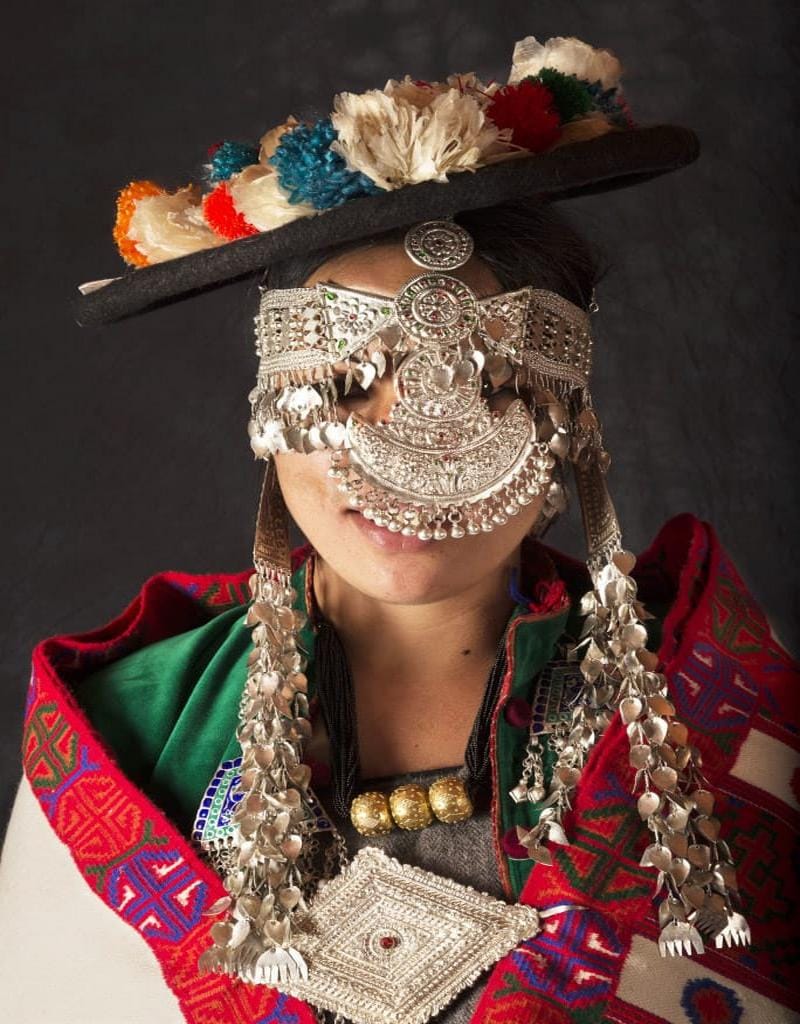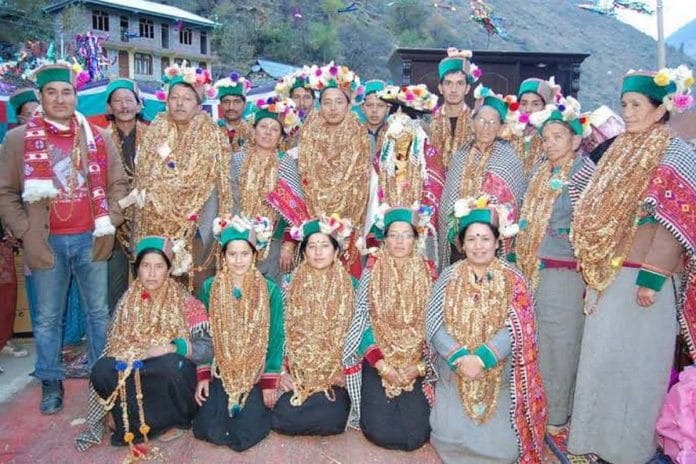Shimla: From glittery lehengas to playfully stealing the groom’s shoes for money, many weddings in north India draw inspiration from Punjabi culture and Bollywood. But a tiny village nestled in Himachal Pradesh’s predominantly tribal Kinnaur district, which lies along the border with Tibet and the Spiti valley, is having none of it.
“We have been observing new trends like mehndi rituals, joota chhipana (hiding the groom’s shoes), cake-cutting, and tying the sehra (head gear for men), which go against our culture. From this date onwards, these practices are to be stopped,” says a 10 March resolution passed by the gram panchayat of Sumra, a village where most residents belong to the indigenous Kinnauri tribe.
The document, written in Hindi and of which ThePrint has a copy, adds that the resolution has been passed “unanimously”.
Sumra is located in Kinnaur district’s rocky Hangrang Valley, which abuts the border with Tibet. Most of the region’s inhabitants belong to local tribes such as the Kinnauri, whose culture is a unique amalgam of Hindu, Buddhist, and indigenous beliefs and practices.
Chhering (he does not use a last name), the vice-president of Sumra gram panchayat, told ThePrint over the phone that the village has just about 80 houses and a population of approximately 300.
Local disapproval over imported practices in Kinnauri weddings has been bubbling for a while, Chhering said, adding that other villages in the region might institute their own “bans” soon too.
“We are all united in this valley. There is an association — Hangrang Rinchen Buddhist Cultural Heritage Foundation — which takes all the decisions relating to our culture and traditions,” he said.
In February, local residents said, this foundation held a meeting of village representatives to discuss the upcoming celebrations for Buddha Purnima. At some point, the topic of weddings came up.
“During the discussion, some people pointed out modern rituals in Kinnauri weddings. All the people present in the meeting decided to take some steps to protect our tribal culture in one voice,” said Saroj Devi, pradhan of Sumra gram panchayat.
According to her, leaders of other gram panchayats also agreed to “pass such a resolution before Buddha Purnima”, which falls on 5 May.
Himachal Pradesh tribal development and revenue minister Jagat Singh Negi, who is the MLA from Kinnaur, told ThePrint that he “welcomed” the resolution and that the panchayat passing it meant that the majority of people in Sumra supported it.
“There are many good things about our Kinnauri culture, and these must be preserved. There is no need to adopt or copy from anywhere else. Any step initiated to protect our culture is welcome,” the minister said.
However, while the resolution underscores mounting anxieties about the erosion of local traditions, a government official in the state’s panchayati raj department said that the wedding “bans” do not carry any legal weight.
Also read: Nagaland loves grand white weddings. It isn’t looking to rest of India for inspiration
No place for saat pheras, Punjabi songs
There is nothing staid about Kinnauri weddings, which traditionally feature plenty of wine, singing, and dancing.
But the appearance of DJ beats and unfamiliar rituals has concerned many residents who view these as a “threat” to their way of life.
Chhering of the Sumra panchayat said “Punjabi music” and events like the “mehndi rasm” (henna ceremony) and saat phere (seven rounds of a sacred fire) are making their appearance in local weddings but are alien to the region’s culture.

Traditionally, he said, Kinnauri women sing folk songs and guests bless the couple in the presence of Buddhist lamas. A grape wine called angoori plays an important role too, he added — it’s offered to the groom’s party when they arrive, and then served to his eldest family member, or majomi, when it’s time for the couple to depart.
Alterations to local attire and accessories are also sore spots for local traditionalists — leading to sehras or turbans being listed among the don’ts in the Sumra resolution.
A groom in the region customarily wears a thepang — a round white or grey woollen cap featuring a wide green, yellow, or red band, depending on his personal preferences. Rather than the ubiquitous achkan or bandhgala of urban north India, he dons a warm shirt called a chaman kurta, paired with pajamas and a long woollen coat, or chubba.
A bride, on the other hand, is decked up in chunky gold and silver ornaments, with dry fruits rather than flowers garlanding her neck.
Her clothing usually comprises a green long-sleeved blouse, a handwoven woollen sari called a dhori, and a colourful shawl featuring bright traditional patterns.
‘Not legally binding’
Safeguarding cherished customs is vital to many in the region, including Prem Negi, vice-pradhan of the panchayat at Nako, another village in Hangrang Valley.
“We all will gather on Buddha Purnima and discuss (passing a wedding resolution). If all panchayats pass the resolution, which is very likely, Hangrang Valley will adopt it in letter and spirit,” he said.
“Some new ceremonies have been added to marriage functions these days. We have a rich culture and our people love to follow it, but sometimes a few get influenced by other cultures. We cannot call it wrong but all our efforts are just to protect our culture,” he added.
But what if a local bride or groom is intent on having cake-cutting or sehra bandi as part of their celebrations? There is, after all, no law against any of the rituals “banned” in the resolution.
Chander Negi, another resident of Hangrang Valley (Nako), said the resolution was not meant to penalise people.
“The idea is not to punish anyone but to encourage them to avoid Western and non-tribal practices. Even the youth here are in favour of this resolution,” he claimed.
An official in the state panchayati raj department told ThePrint on the condition of anonymity that the resolution was an “internal matter” of the region.
“No one can force any person to adopt any wedding ritual. This resolution may be a part of an awareness drive to protect local culture, but it is not legally binding on anyone,” he added.
‘Emotion needs to be understood’
Dr Ranvir Singh, a retired sociology professor, highlighted the deep attachment Kinnaur’s people have to their rich cultural heritage.
“In the past few years, some modern rituals have influenced the region, but it is interesting to see that young people still follow their culture,” he said. “This resolution should not be seen in terms of legality, but the emotion behind it needs to be understood.”
Kinnaur social activist Rattan Manjari, well known for her advocacy of tribal women’s property rights, also acknowledged that the legal validity of the resolution was open to question, but emphasised that the primary issue at hand was the preservation of culture.
“We have a close-knit society, and our rituals hold significant social standing. However, we have noticed some dilution in their practice in recent years,” she told ThePrint. “This is all about protecting our culture. It should not be diluted.”
(Edited by Asavari Singh)
Also read: Inside ‘Ghar Wapsi’ of Chhattisgarh tribals: RSS women priests reach out, royal washes feet






